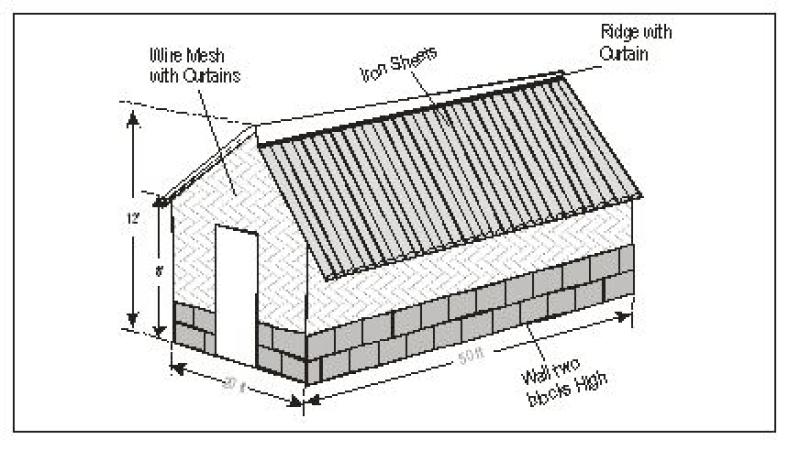You want to venture into poultry farming as a business?

Chicken housing
Building good and affordable poultry house step by step
The success or failure of a poultry business is pegged on many things; but one critical factor is getting the housing right.
Commercial chicken farming requires a high level of expertise, understanding and commitment. While it is important to emphasize the need for excellent flock stockmanship at all times, something that comes with experience and aptitude, adopting the correct housing techniques and equipment will set a firm foundation.
The ideal house should provide the birds with a comfortable environment and protect them from extremities of the prevailing weather (rain, wind, sunshine). The house should provide adequate space for the flock.
Ideal stocking density:
Two square foot per bird (2sqfoot/bird) for layers
One square foot per bird (1sqfoot/bird) for broilers.
In the tropics, the ideal house is open-sided to allow natural ventilation and have an east-west orientation to minimise amount of sunlight entering the house directly.
It is important that the house be rectangular and have walls not higher than three feet (3) on the longer side.
The wall can be made from:
Stones
Iron sheet
Timber,
Silver board
Bricks
Comfortable and well ventilated
The rest of the side of the wall should have a chicken wire mesh. The roof of the house should have a reflecting surface and pitched with overlaps (see diagram above) all these factors aid in ensuring that the house is comfortable and well ventilated.
Cement floors are the best finishing as they are easier to clean. There should be a foot-bath at the entrance of the house for those entering to disinfect their foot wear. To reduce the risk of rodents gaining entrance into the flock house, clear all the vegetation in an area 3-5 metres around the flock house.
The feed store should also be separate from the house. The flock house should be constructed in isolated areas to minimize the risk of contamination. It should be fenced to exclude stray animals and visitors. The doors should always be locked. The wire mesh on the sides of the house should be of a small gauge to prevent wild birds, dogs and rodents.
In poultry farms, an all-in all-out system is the best management practice as it prevents the buildup of disease causing organisms and disease outbreaks. In case where farmers want to keep flocks of different ages, then each flock must be housed in its own unit.
Minimise wind
Ventilation is basically the circulation of fresh air through the flock house and exhaustion of stale air out of the flock units. This is achieved by the air passing from one side of the houseand exhausting through the opposite side.
Ventilation of poultry houses serves several functions including:
Removing excess heat and moisture
Providing oxygen while removing harmful gases.
Reducing dust hence improving the air quality
In the tropics, where houses are open-sided, ventilation is managed by opening the curtains from top when it gets warm. This lets air from outside into the house. When it gets cold, the curtains are raised up and closed to restrict the flow of air. You must always allow minimum ventilation to avoid chicks getting suffocated.
Curtains are normally made from clean and disinfected feed sacks stitched together. The curtain should be fastened to the side-wall at the bottom and opened from the top.
This will minimise wind or drafts blowing directly on the birds. To ensure effective ventilation, every effort should be made to open the curtain on both sides of the building to the same level unless wind is consistently from one side of the flock house then the curtain on the side should be opened less than the other side.
Houses should be constructed to take advantage of prevailing winds to improve efficiency of natural ventilation. Narrow house (10 metre/33 feet or less) with higher pitched roofs provide more natural air movement. An east-west orientation of the flock house on its long axis reduces the solar heat level in the house.
For more information contact your nearest poultry centre.
[Dr Watson Messo is a Veterinary Surgeon.
He works at Kenchic as Head Vet
[email protected]]
Want to get latest farming tips and videos?
Join Us
Share this article on social
 The Standard Group Plc is a multi-media organization
with investments in media platforms spanning newspaper print operations,
television, radio broadcasting, digital and online services. The Standard Group
is recognized as a leading multi-media house in Kenya with a key influence in
matters of national and international interest.
The Standard Group Plc is a multi-media organization
with investments in media platforms spanning newspaper print operations,
television, radio broadcasting, digital and online services. The Standard Group
is recognized as a leading multi-media house in Kenya with a key influence in
matters of national and international interest.
 The Standard Group Plc is a multi-media organization
with investments in media platforms spanning newspaper print operations,
television, radio broadcasting, digital and online services. The Standard Group
is recognized as a leading multi-media house in Kenya with a key influence in
matters of national and international interest.
The Standard Group Plc is a multi-media organization
with investments in media platforms spanning newspaper print operations,
television, radio broadcasting, digital and online services. The Standard Group
is recognized as a leading multi-media house in Kenya with a key influence in
matters of national and international interest.







